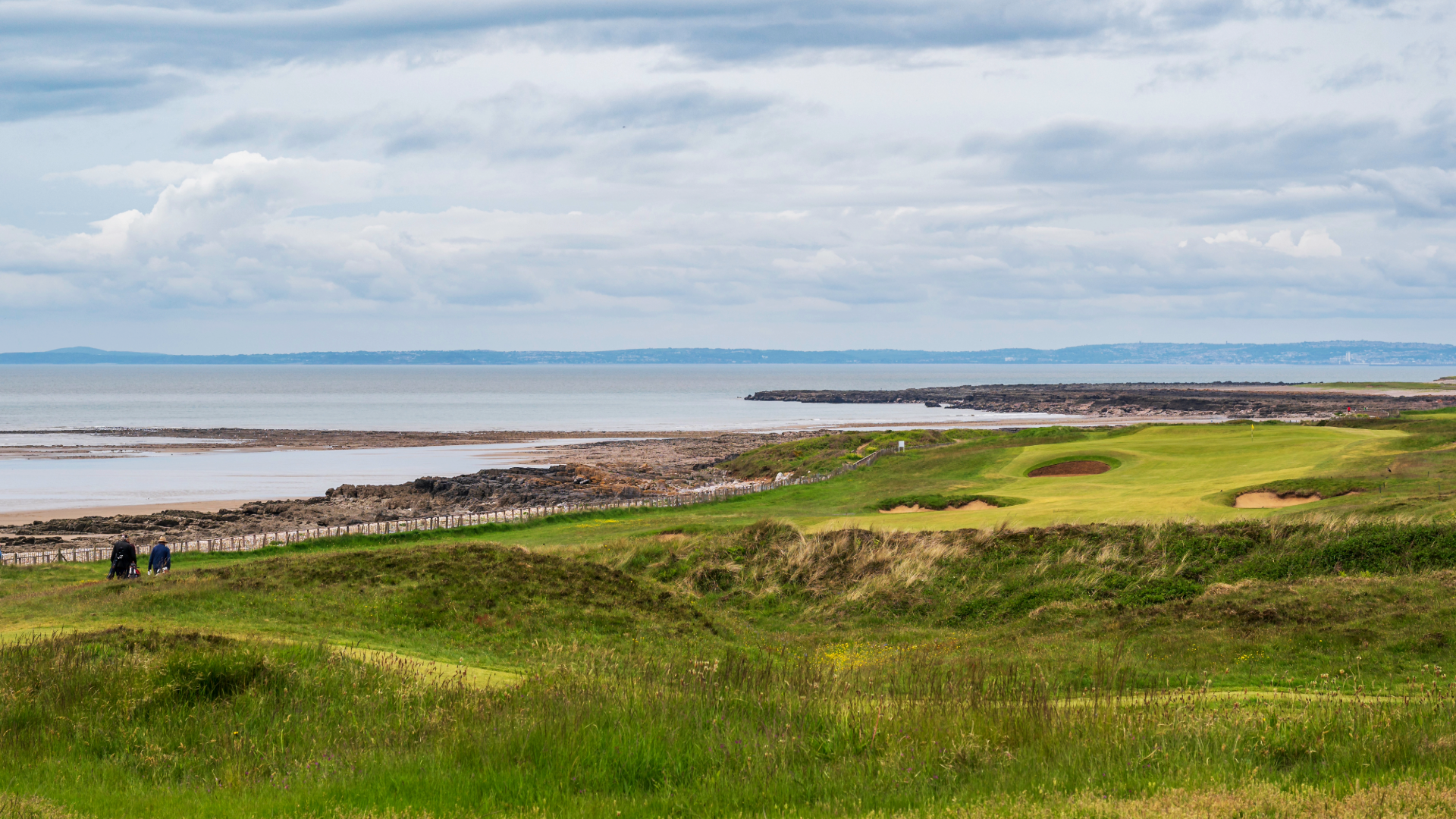
There’s a reason why The Open Championship looks and feels so different from other major golf tournaments—especially when the wind picks up. It’s the definition of a links golf course.
This month, The Open returns to Royal Portrush in Northern Ireland, a breathtaking coastal course that perfectly embodies the wild and unpredictable nature of links golf. It’s a night and day difference from the courses and conditions often played in United States tournaments.
For professional golfers, Portrush presents a mental and physical test unlike anything on the PGA Tour. For amateurs and beginners watching at home, it’s a front-row seat to one of the best learning opportunities in the game.
If you’ve ever played golf in the wind, you already know how tough it can be. But when you understand how links courses work and how the pros adapt their games, you can turn that frustration into confidence.
In this post, we’ll break down what exactly a links course is, why the layout makes things so tricky, and give you specific tips to adjust your swing, strategy, and mindset for success in these conditions. Whether you’re playing in Scotland or just facing a windy day at your local muni, these strategies will help you master any links golf course.
The Ultimate Guide to Links Golf
If you’ve only played golf in the United States, your experience is likely with “parkland” courses—lush, tree-lined, and fairly predictable. But links golf is a different beast altogether.
A links course is typically built on coastal land, often featuring sandy soil, natural dunes, and a layout shaped more by wind and weather than by bulldozers. Some defining features of links courses include:
- Firm, fast fairways that encourage low, rolling shots
- Deep pot bunkers that act like sand traps on steroids
- Massive, undulating greens with unpredictable breaks
- Very few trees, which means the wind is always a factor
- Tall fescue grass (sometimes knee-high) and uneven lies in the rough
Unlike most American courses where high, spinning wedge shots are the norm, links golf rewards creativity, patience, and keeping the ball low to the ground. It’s not about how far you hit it—it’s about how well you can control your ball flight and bounce.
Why Wind Is a Game-Changer in Links Golf

Royal Portrush is a world-class links course—but what truly elevates the challenge is the wind. Situated on the rugged coastline of Northern Ireland, Portrush is constantly exposed to shifting gusts that can turn even a simple par 3 into a puzzle.
At The Open, it’s not uncommon to see players clubbing up or down by two or more clubs, depending on wind direction and strength. What makes links golf so different from what most amateurs are used to is how unpredictable and unforgiving it can be in the wind.
A well-struck shot can suddenly balloon, stall, or sail 30 yards past your target. A short par 4 might play like a par 5 into a headwind—and vice versa with a tailwind. For example, at the 2019 Open at Portrush, champion Shane Lowry described the wind as “a shot-by-shot adjustment.”
Players hit stingers, punch shots, and bump-n-runs to keep the ball under the wind. Many avoided flags entirely, choosing safer areas of the green or even using long putts from well off the surface.
Watching how professionals adapt to the wind at Royal Portrush is a masterclass in control and discipline. For amateurs, it’s the perfect time to take notes.
Tips for Playing Links Golf and Windy Conditions
Whether you’re teeing it up on a breezy day at your local course or planning a bucket-list trip to Scotland or Ireland, here are some battle-tested tips to help you play smarter when the wind picks up.
1. Understand the Wind
The most important rule in windy conditions? Don’t rush your pre-shot process.
Take time to assess both the direction and strength of the wind before choosing your club and target. Then, factor in how it will affect your shot’s trajectory, distance, and spin:
- Headwind: The most difficult wind to manage. Your ball will balloon and exaggerate misses—especially with longer clubs. Expect minimal spin once it lands on the putting surface. You might need to take up 1–3 clubs, maintain a smooth rhythm, and hit a knockdown. Don’t swing harder; more spin = higher flight = more wind interference.
- Tailwind: The ball will fly lower, go farther, and have less backspin so plan for more rollout. You might consider landing the ball short to bounce up depending on distance and conditions.
- Crosswind: Don’t fight it—ride it. For example, in a left-to-right wind, don’t try to hit a draw to “offset” the wind unless you’re highly skilled. Most amateurs will get in trouble trying to “work the ball.” Instead, aim accordingly and let the wind do the work.
“When it’s breezy, swing easy.”
2. Hit More Knockdown Shots
In the wind, you want a shorter swing with less loft to keep the ball flight low. Think shoulder-to-shoulder swings with a smooth tempo. Use more club and make a controlled swing—a 7-iron might be the best play even from 100 yards.
High shots get eaten up by the wind. Knockdowns are more reliable and will keep you in play to improve consistency when conditions get tough.
3. Use the Ground Game
Links golf is all about creativity and control. Instead of trying to hit perfect wedge shots, use the turf to your advantage.
Try a bump and run with a 7- or 8-iron instead of a lob wedge. These shots stay low, roll like a putt, and are more predictable on firm links turf.
If your short game needs help but don’t have time to practice, the ONE Wedge is a perfect solution for amateur golfers looking to hit chunk-free shots with ease.
4. Expect Longer Putts
Links courses are known for massive greens with subtle breaks and slower speeds. This means you’ll often face 40–60 foot putts—and three-putts are more common than you think.
Spend plenty of time on the practice green working on speed control before your round. That alone can save you strokes. If your putting needs work, check out the SQ Putter to improve consistency and confidence on the greens.
5. Have a Clear Plan for Every Shot
In tough conditions, clarity is everything. Pick a target, choose a club, commit to a ball flight, and trust it.
Second-guessing leads to tension and poor execution. Stick to your routine, visualize the shot, and adjust your plan for wind and ground conditions—but don’t overcomplicate it.
6. Adjust Your Expectations
Most importantly, give yourself grace. In links golf and windy conditions, par is a great score.
Bogeys are okay. Avoid getting discouraged if things don’t go perfectly—no one plays flawless golf in the wind, not even the pros.
Stay patient, play smart, and remember: playing well in the wind is less about power and more about control, creativity, and course management.
Embrace the Wind, Embrace the Challenge
As the saying goes, “When it’s breezy, swing easy.” That’s more than a rhyme—it’s a solid golf strategy.
The wind can be frustrating. So can firm turf, odd bounces, and 40-yard lag putts. But once you understand the challenge of links golf, you realize it’s not about fighting the course—it’s about learning to play with it.
That’s what makes watching The Open Championship so valuable. At Royal Portrush, you’ll see the world’s best players deal with the same variables we all face—weather, pressure, bad breaks—and still find ways to compete at the highest level.
So whether you’re watching The Open this summer or heading out for your next round in breezy conditions, remember: the wind doesn’t have to ruin your game. It can sharpen it with the right attitude.

